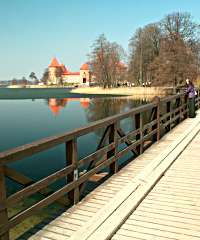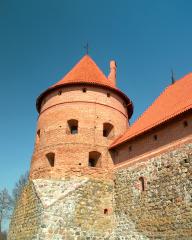Trakai
|
|
Trakai-Troki.jpg
Trakai (Polish Troki) - a town and lake resort in Lithuania, a part of Trakai national park territory and an administrative centre of the region. Town facts:
- Territory: 11,520 m²
- Inhabitants: 6.142 people
Region facts:
- Territory: 12,027.4 m²
- Inhabitants: 38.200 people
The town is located 28 km west of Vilnius. There are 200 lakes in the region, of which the Galvė lake covers an area of 3.88 km², Vilkokšnis lake - 3.37 km², the lake of Skaistis - 2.96 km². There are Trakai Historical National Park and Aukštadvaris Regional Park founded in the territory of the region.
Trakai Historical National Park was founded in April 23, 1991 to preserve Trakai as a centre of Lithuanian statehood as well as its authentic nature. It is the only historical national park not only in Lithuania but also throughout Europe. The territory of the park covers 82 km², 34 km² of which are covered by forests, and 130 km² are covered by lakes.
Aukštadvaris Regional Park was founded in 1992 to preserve the valuable landscapes of Verknė and Strėva upper reaches. The area of the park is 153.50 km², most of which is covered by forests. There are 72 lakes here, the biggest of which is Vilkokšnis.
The town of Trakai
The first settlements in this area appeared at least in 1 millennium A.D. The town as well as its surroundings started developing in the 13th century as a The Grand Duchy of Lithuania centre. According to cronicles, Grand Duke Gediminas after a successful hunt found a beautiful place not far from the then capital Kernave and decided to build a castle here. That is how a new castle was built in Senieji Trakai which at that time was called Trakai. The town of Trakai was first mentioned in German chronicles in 1337, which is regarded to be the official date of its foundation. When Grand Duke Gediminas finally settled in Vilnius, Senieji Trakai was inherited by his son the Duke Kęstutis. This is the birthplace of the most famous ruler of Lithuania - Vytautas the Great.
During the reign of Kęstutis Naujieji Trakai was a place of intensive construction: one castle was built in the strait between lakes Galvė and Lukos, another one - on an island in lake Galve. A village grew around the castle. The approaches of Trakai were protected by Senieji Trakai (Old Trakai), Strėva, Bražuolė, Daniliškės and other mounds. When Vytautas became the vassal ruler of the Grand Duchy of Lithuania, Trakai became a political and an administrative centre. Construction of the castles was finished and a catholic church was built. The distinctive feature of Trakai is that the town was built and preserved by people of different nationalities. Here lived communities of Karaims or Karaites (small Turkic-speaking ethnics group resettled there by Grand Duke Vytautas in 14th century from Crimea), Tatars, Lithuanians, Russians, Jews and Poles. Both Christian and Karaites communities were granted separate self-government - Magdeburg Rights.
Some famous Karaim scholars were active in Troki in the 16th and 17th centuries, such as Isaac ben Abraham of Trakai (1533? - 1594?), Joseph ben Mordecai Malinovski, Zera ben Nathan of Trakai, Salomon ben Aharon of Trakai, Ezra ben Nissan (died in 1666) and Josiah ben Judah (died after 1658).
Some of the Karaims became wealthy. Trakai lost its political significance in the 16th century and declined economically when Lithuania was incorporated with Poland. The Karaims suffered severely during the Chmielnicki massacres of 1648 and the wars between Russia and Poland in the years 1654 - 1667, when the town was plundered and burnt, the castles were destroyed. In 1680 only 30 of their families were left in Trakai. The town was left in ruins again early in the 18th century (1702?), by the wars of Karl XII of Sweden, and by the ensuing famine and plague, till only 3 Karaim families were left. By 1765 only 300 Karaims lived in Trakai. Catholic missionaries made serious attempts to convert the local Karaims into Christianity, but failed in the end.
Missing image Trakai_castle_right.jpg Right pillon of the Castle of Trakai |
The island castle was rebuilt in the second half of the 20th century. There has been a history museum in the castle since 1962. In summer different festivals and concerts take place in the island castle. The town of Trakai is widely reflected in post stamps.
Trakai is a town built on water. The town is surrounded by the lakes of Lukos (Bernardinų), Totoriškių, Galvės, Akmenos, Gilušio. There are a number of architectural, cultural and historical monuments in Trakai.
The town of Trakai signed a partnership agreement with the city of Rheine in Germany in 1996. In 1997 a partnership agreement was signed with Malbork city in Poland.
External link
- Trakai Town Site (http://www.trakai.lt)
de:Trakai lt:Trakai no:Trakai kommune pl:Troki ru:Тракай tt:Trakai





